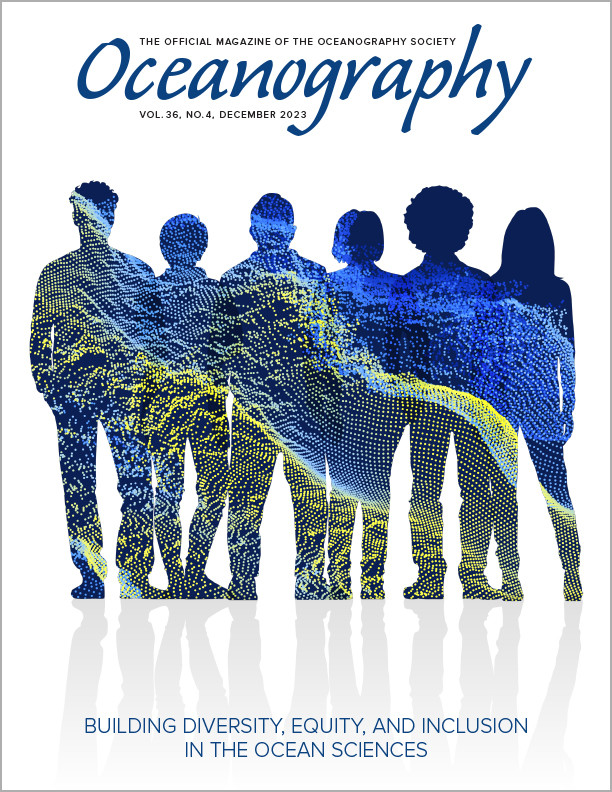Introduction
A landmark National Science Board report (NSB, 1986, p. 2) stated that, “Unless education in mathematics, engineering, and the sciences is made more effective for all students and more attractive to potential faculty members, and especially to the presently underrepresented [students], both the quality and number of newly educated professionals…will fall well below the Nation’s needs.” This report called attention to the poor condition of STEM education in the United States and the need to open the STEM workforce to everyone.
Addressing workforce shortages is critical, and having a diverse, equitable, and inclusive learning and working environment is beneficial. For example, people with different backgrounds and perspectives approach challenges differently, often leading to better problem-solving. As expressed by Bennett et al. (2020), “Broadening participation of underrepresented groups (URG) in the [STEM] fields is critical to maintaining and growing US competitiveness in innovation, the knowledge and science economy, and broadly equipping the twenty-first century workforce.” Additionally, a diverse group creates “superadditive” rather than linear capabilities (Page, 2007) and a host of other things (Phillips et al., 2014). For example, racial and opinion diversity among college students was perceived to increase novelty in discussion, as measured by Antonio et al. (2004). Despite its benefits, the challenges of obtaining a diverse STEM workforce have existed for decades.
After the 1986 National Science Board report, the National Science Foundation (NSF) Directorate for Geosciences developed initiatives to address this challenge (D’Elia, 1989). Success and equity for women in the NSF Graduate Fellowship program have since increased markedly (Cook et al., 2022). However, building diversity, equity, and inclusion (DEI) in the ocean sciences has been a particularly nettlesome issue (Bernard and Cooperdock, 2018).
The physical sciences stand out among STEM fields for their limited progress in addressing diversity challenges (NSB, 2019; Trapani and Hale, 2019; Speer, 2023). With the growing percentages of minority populations, US demography has changed considerably in the last 40 years (US Census Bureau, 2022), amplifying the challenge and leaving an even larger part of the future workforce underrepresented than in 1986. High school curricula include few physical science courses, affecting all students (van Norden, 2002; McNeal, 2010). Although the “geosciences deficit” begins in secondary education, it cascades to students at the doctoral level.
Many students, especially first-time-in-college (FTIC) students, are challenged to navigate the complex network of pathways from K–12 education to earning a doctoral degree. The traditional metaphor “STEM educational pipeline” is overly simplistic, implying a single path (Speer, 2023). In fact, a complex STEM pipeline system leads students to qualify for faculty positions. A recent Association of Public & Land-Grant Universities (APLU) report (Bennett et al., 2020) notes, “[Those unfamiliar with STEM education] are apt to be confused by unfamiliar academic territory with extensive emotional hills and valleys [‘speedbumps’] and poorly marked trails as well as wide open spaces of potential.” Figure 1 demonstrates this intricate network, its “leaks” and “speedbumps” that slow underrepresented students’ progress toward becoming faculty members. Plugging leaks and anticipating speedbumps in the system requires sophistication and advisement that students often do not have.
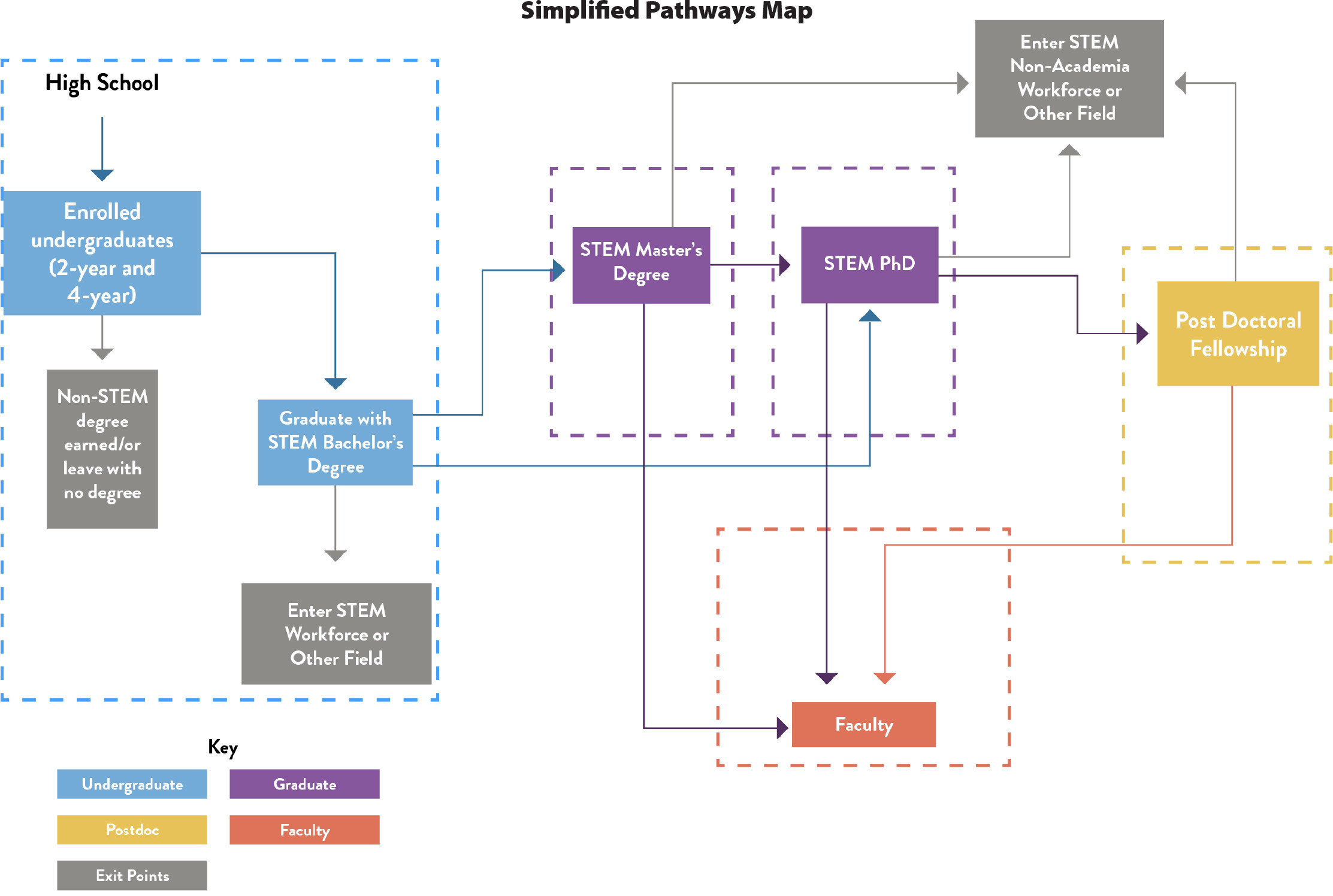
FIGURE 1. Complex pathways can lead to faculty qualifications. Association of Public & Land-Grant Universities (APLU) model (Bennett et al., 2020), used with permission. > High res figure
|
The “STEM pipeline system” metaphor has alternatives. The “braided river model” (Figure 2) of STEM workforce development (Batchelor et al., 2021) is quite apt. Like the APLU pipeline system model, the braided river model recognizes a complex matrix of paths that apply to the needs of any given individual. As Briscoe et al. (2016) point out, career possibilities available to students are many and do not just lead to faculty jobs in universities. This observation is very consistent with the braided river model.
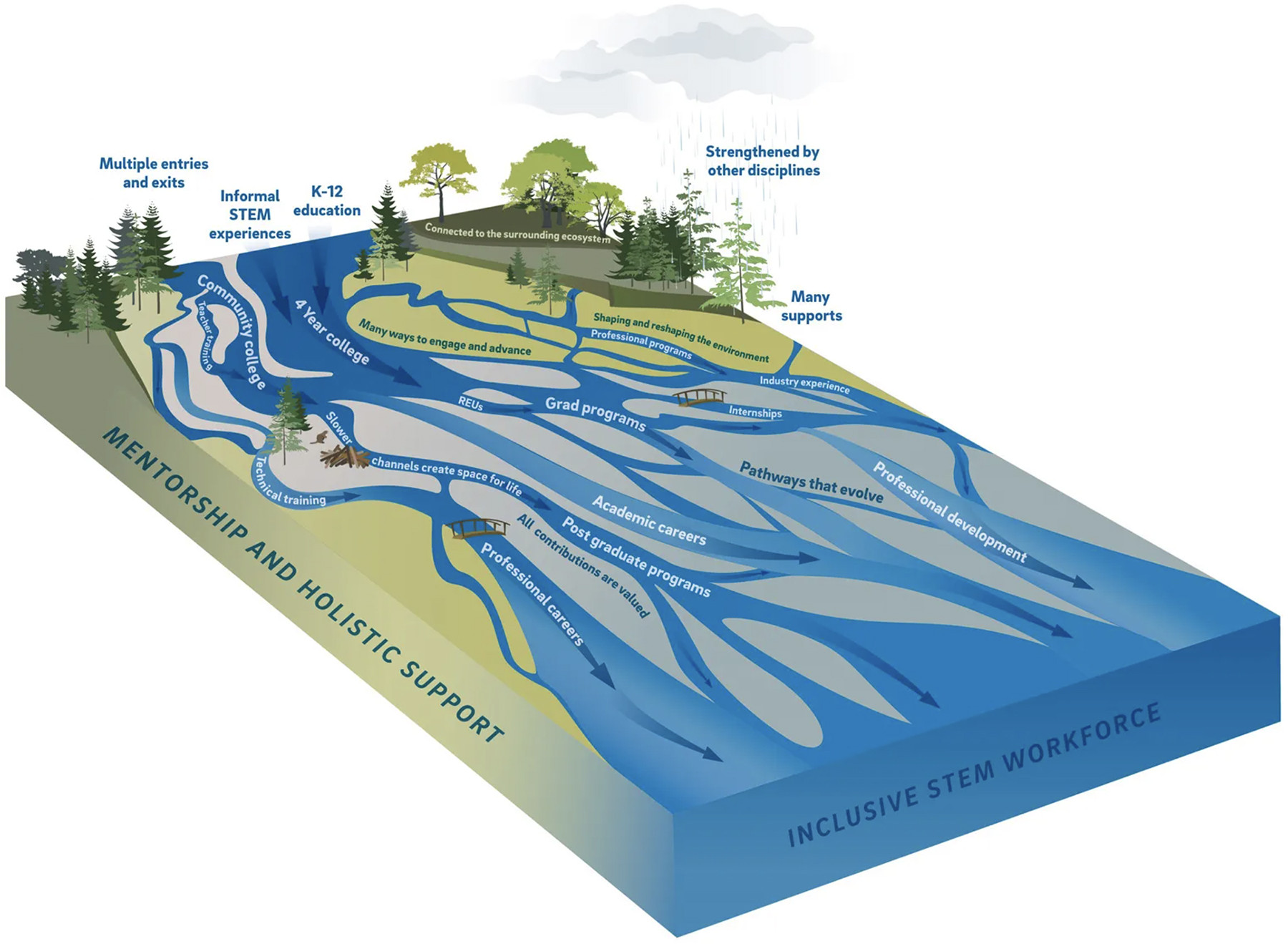
FIGURE 2. The braided river model (Batchelor et al., 2021) provides a more complex view of pathways toward faculty qualification. Used with permission. > High res figure
|
We draw two conclusions from these models. First, a complex series of actions must be undertaken to ameliorate the STEM geoscience DEI challenges. Second, because student needs differ, personal and individualized advisory support and mentorship are essential. This is consistent with the braided river model.
A Multi-Faceted Approach to Improve DEI
The Louisiana State University College of the Coast & Environment (LSU CC&E) employs a multifaceted, “systems approach” to foster a college-wide culture to address DEI issues. Strong advisement and mentorship are intrinsic. These strategies are based on research about DEI in STEM fields and a critical evaluation of CC&E’s progress over the past 14 years. They address multiple points of vulnerability. Faculty, staff, and students are encouraged to participate according to their own interests and capacities (Crawford et al., 2018). As a small college with a low budget, external funding is essential for its DEI efforts.
CC&E has achieved gender parity in its degree programs but needs to increase ethnic, economic, and racial diversity. Augmenting diversity in PhD graduates from underrepresented groups is of paramount interest due to the high demand for positions in academia (Trapani and Hale, 2019).
CC&E developed its first Diversity, Equity, and Inclusion Action Plan in 2020 (LSU, 2020a) to complement the LSU Diversity & Inclusion Roadmap 2020–2022 (LSU, 2020b). CC&E has 46 faculty, over 300 undergraduate and graduate students, and research and administrative staff. Everyone cooperates to foster the college’s DEI efforts. Note that LSU defines “underrepresented” as Black, Latino/Latina, two or more races, Native American, and Native Hawaiian. Often, low-income and FTIC students are also considered to be underrepresented groups. For reference, in Louisiana, 62% of the population is White, 33% is Black, and the remaining 5% is from other groups (US Census Bureau, n.d.).
A college-wide DEI committee, chaired by an associate dean and comprised of faculty, staff, a student, and an alumnus, has created four strategic initiatives: augmenting the student pipeline, building faculty ranks, reinforcing a culture of inclusion, and improving pedagogy (Figure 3). All four are complementary and reinforcing.

FIGURE 3. Elements of the Louisiana State University College of the Coast & Environment (LSU CC&E) diversity, equity, and inclusion (DEI) initiative are illustrated here. > High res figure
|
Augmenting the Student Pipeline
The Diversity, Equity, and Inclusion Action Plan aims to augment student diversity and success through mentoring students throughout their academic careers, recruiting nontraditional students to CC&E, providing travel funds for prospective graduate student visits, and increasing interest in geosciences and related careers for 6–12th graders who are potential students. We provide more details below.
Pathway to Student Success: Continuous Mentoring Throughout the Undergraduate Experience
Mentoring (Johnson et al., 2016; Marshall et al., 2022) is a DEI best practice in the physical sciences. CC&E implemented a “Pathway to Student Success” initiative (Figure 3) to provide each student with continuous mentoring as needed. The initiative starts with personal experiences (growth, motivation, commitment, and engagement) and follows up with place-based learning experiences in internships, research, and professional preparation (Gruenewald, 2003). Four required courses, one for each academic year, provide an orientation to the curriculum, enhance engagement, ensure equal access to academic and research opportunities, and teach necessary career skills (Huntoon and Baltensperger, 2012). A first-year course, 1010, introduces students to CC&E’s research fields; 2020, for second-year students, is a hands-on course to build research experience and faculty engagement; 3030 provides third-year students with career preparation advice and “soft skill” instruction; 3999 gives students opportunities to conduct independent research under the guidance of a faculty advisor; and 4999 is a capstone course in which students synthesize the hard and soft skills gained in previous years (Figure 4). This course sequence offers every student new perspective, reinforces awareness of university resources, and provides annual checkpoints for individual students.
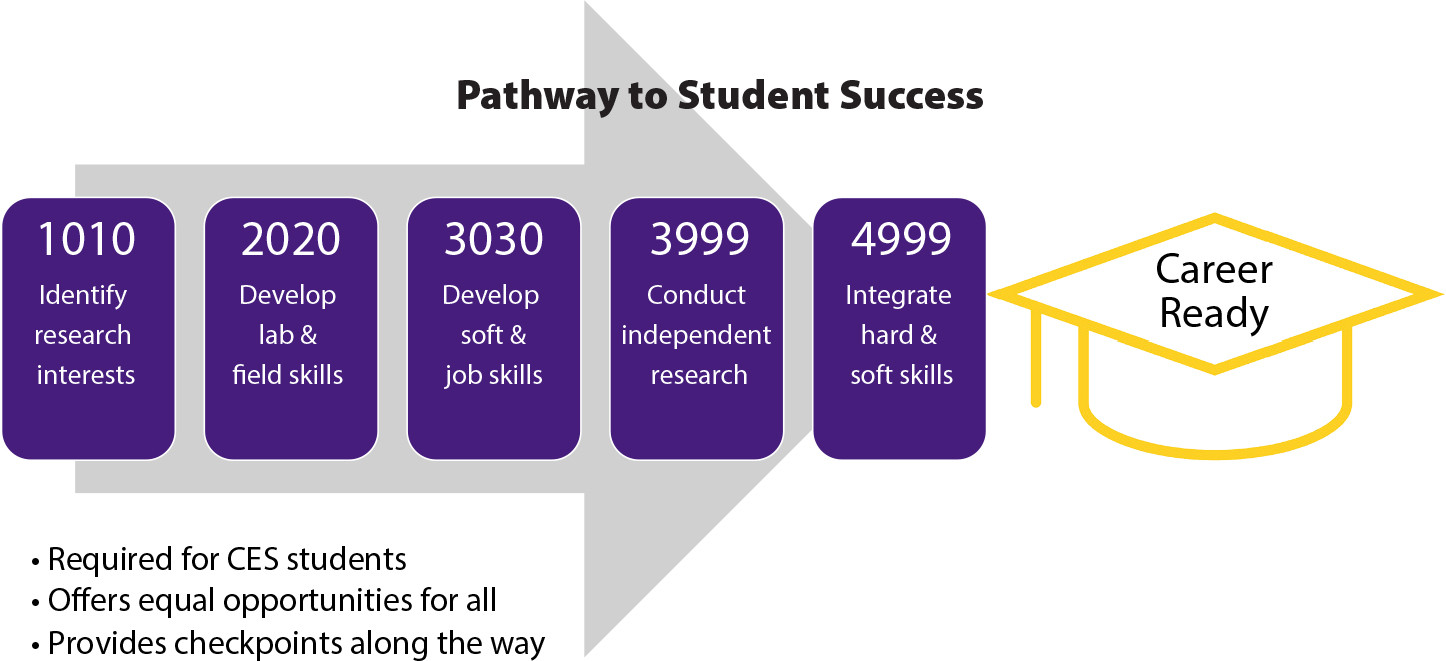
FIGURE 4. CC&E’s “Pathway to Student Success” initiative includes these five required courses. > High res figure
|
Partner with a Local Community College to Attract Nontraditional Students
Recently, CC&E reinvigorated a program with Baton Rouge Community College (BRCC), a two-year institution with 46% of its student body from Black communities (College Factual, 2023). This 2+2 program enables qualified students to articulate from BRCC to the Coastal Environmental Science bachelor of science program. BRCC students get mentorship from LSU through lectures, one-on-one access to CC&E faculty, and intensive orientation during a two-week-long summer bridge program. Once students matriculate at LSU, they are placed in CC&E faculty laboratories that align with the students’ interests. Mentoring efforts continue until graduation.
Recruit Graduate Students Through Funded Visits to CC&E
Increasing diversity in CC&E’s doctoral programs remains challenging and requires proactive approaches with existing and prospective students. Through academic courses, workshops, and discussions with mentors, CC&E informs students about career options for those with doctoral degrees and partners with local Historically Black Colleges and Universities to diversify the coastal and environmental workforce. CC&E created a competitive fund to provide partial travel funds for prospective graduate students to visit LSU.
Increase Interest in the Physical Sciences in 6–12th Grade Students
CC&E takes a longer-term approach to diversifying its student body by increasing student interest in coastal and environmental studies at the middle and high school levels, including providing students and parents with information on career options and salaries. Highlights of multiple efforts led by CC&E are described below.
- Mayfair Laboratory School is a local K–8 academic magnet school with a focus on environmental studies through an “ecoSTEM” initiative. ecoSTEM is embedded into all grade levels, content, activities, clubs, and events. CC&E faculty and students volunteer at Mayfair to develop ancillary lesson plans and advise students on annual environmental projects. CC&E faculty created a laboratory and weather station with guided geoscience exercises. Mayfair enrolls more than 460 students: 50% are minority students and 22% are economically disadvantaged (US News & World Report, 2023).
- Opened in 2021, the Eva Legard Center for Coastal & Environmental Studies (https://ebrschools.org/schools/evalegardcenter/) is a 6–12th grade “focus choice” public school located in Baton Rouge that incorporates the coastal environment into its curriculum, activities, clubs, and events. As a founding partner in launching this school, LSU provides professional development for the teachers along with curriculum support, leads field trips, supports recruitment activities, and coaches students and parents. The curriculum has been designed to transition qualified graduates to CC&E’s Coastal Environmental Science program. Within four months after the school opened, students achieved a 40% increase in competency in math and a 30% increase in competency in English language arts. The school’s phenomenon-based instructional approach employs hands-on and place-based learning (Gruenewald, 2003; Langran and DeWitt, 2020; Kangas and Rasij, 2021). Seventy-eight percent of students in this school are African American and Latino/Latina.
- CC&E and Louisiana Sea Grant host the LSU EnvironMentors program, part of a network developed by the National Center for Science and the Environment (https://www.gcseglobal.org/). Since 2010, CC&E has partnered with Scotlandville Magnet High School, a local school that draws 98% of its student body from Black communities (Public School Review, n.d.), to pair high school and LSU students. Students and their mentors collaborate on a year-long research project (Monk et al., 2014). Each protégé’s work culminates with participation in a poster competition to present research findings. Though available human and financial resources limit the program to fewer than 15 high school students per year, its value is proven as program graduates often pursue higher education, with at least 12 “alumni” having earned undergraduate degrees at institutions of their choice, including LSU.
- CC&E’s activities extend beyond Baton Rouge in collaboration with JASON Learning (https://jason.org/), a nonprofit dedicated to providing a “real-world STEM curriculum for the classrooms of tomorrow.” Co-hosted by JASON and CC&E, superintendents from across the nation traveled to LSU in 2022 to attend AASA’s (The School Superintendents Association; https://www.aasa.org/) STEM Leadership Consortium workshop.
Building the Ranks of Our Faculty
With few underrepresented students earning PhDs in the physical sciences (Trapani and Hale, 2019) and a high demand for faculty from underrepresented communities, recruiting from a diverse applicant pool for faculty positions is difficult. CC&E seeks to diversify its applicant pool for open positions and appoints a DEI representative to serve on each search committee. Additionally, the college appoints underrepresented adjunct faculty to serve on graduate student committees, teach classes, develop new courses, collaborate on research, and join field trips. Department chairs are responsible for advising adjuncts and ensuring that searches have diverse candidate pools.
Reinforcing a Culture of Inclusion
CC&E’s most recent undergraduate retention rate is 89.6%. Providing a culture of inclusion for all students, faculty, and staff fosters retention in this rigorous, science-based program. CC&E enhances communication, builds trust, creates a sense of belonging, and provides a voice for all. CC&E offers DEI training for faculty, staff, and students and hosts scientific seminars featuring diverse speakers. These actions help sustain an environment in which race, gender, individual perspectives, ideologies, and other differences are respected, encouraged, appreciated, and valued (Bezrukova et al., 2016).
Faculty seek external funding for DEI activities. For example, a grant from the US Geological Survey Climate Adaptation Science Centers (CASC) program (https://www.usgs.gov/programs/climate-adaptation-science-centers) supports an undergraduate research experience for individuals from underrepresented communities, provides professional development grants for graduate students studying climate science, and fosters discussions with two Historically Black Colleges and Universities on collaborative opportunities. We partner on this with Auburn University, Savannah State University, and Jackson State University. Such inter-university partnerships yield new perspectives and networking opportunities.
Improving Pedagogy
CC&E continually improves its quality of teaching, modifying both methods and practices as needed to create a deeper understanding of the subject matter. To help CC&E embrace new ways to educate students from diverse backgrounds, CC&E has developed a digital resource library and created a webpage for CC&E’s DEI initiatives (https://www.lsu.edu/cce/about/dei). New faculty members are assigned peer mentors to facilitate their successful transitions to academic and research programs.
Summary of Progress to Date
The obvious question is: “Have these actions increased the diversity of the college?” In a word, “yes.” We are closing the gap and enrolling many more underserved individuals, particularly in our undergraduate program (Figure 5). (Because graduation lags enrollment, we do not include graduation data here.) While we are starting to see increases in our MS and PhD programs, they are less dramatic than in our BS program. We do know that many of the graduates of our BS program go on to graduate programs elsewhere.
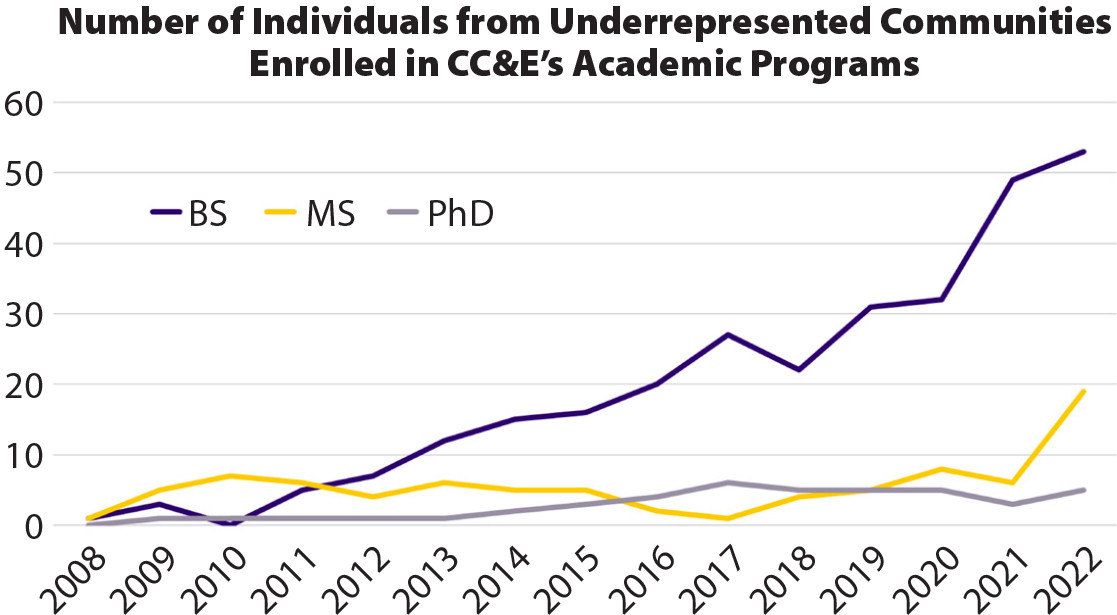
FIGURE 5. Enrollment growth in underrepresented students is charted since the inception of CC&E’s bachelor of science program in 2008. > High res figure
|
To summarize, CC&E employs a multifaceted systems strategy to address complex STEM education pipeline network vulnerabilities, link the college’s DEI strategy to LSU’s institutional DEI strategy, and develop strategic partnerships that advance the goals of the college. While our approach is tailored to our unique situation, elements of it may be useful for others to model. CC&E does the following:
- Helps middle and high school students to develop an interest in physical sciences through such efforts as communicating with teachers, students, and parents about career options and salaries in the geosciences
- Works with local schools to recruit students and align our academic programs
- Employs multiple tactics to retain students that include continuous mentoring throughout their academic journeys and mandatory advising each semester for all undergraduate students
- Informs LSU students about career options and student exchange programs
- Engages students in laboratories as early as their first years
- Provides hands-on experiences in the natural environment such as academic and research excursions on boats in bayous and marshes
- Seeks to diversify our faculty by encouraging faculty from underrepresented communities to apply for open positions and recruiting and integrating diverse adjunct faculty into CC&E activities
- Reinforces an inclusive culture through mentoring and training opportunities for faculty, staff, and students
- Invites scholars from underrepresented communities to campus for lectures and collaboration
- Provides resources to assist with pedagogy
- Seeks external funding for DEI initiatives
- Recognizes faculty, student, and staff efforts to enhance DEI in the college
- Maintains an inclusive institutional climate that recognizes the value of DEI initiatives
Consistency, longevity, stability, and an “all-hands” approach facilitate these initiatives. Having matriculated the most diverse graduate student cohort ever, CC&E is proceeding to its goal of diversifying enrollment in doctoral programs and graduating more PhDs.
Acknowledgments
We thank APTIM, the Global Council for Science and the Environment, Louisiana Sea Grant Program, the USGS CASC program, the W.M. Keck Foundation, and the National Science Foundation for Award No. 2226565 to CFD and LHB. We gratefully acknowledge our DEI partners including the LSU College of Human Sciences and Education, Auburn University, the East Baton Rouge Parish School System, Jackson State University, JASON Learning, LSU EnvironMentors, and Savannah State University.

